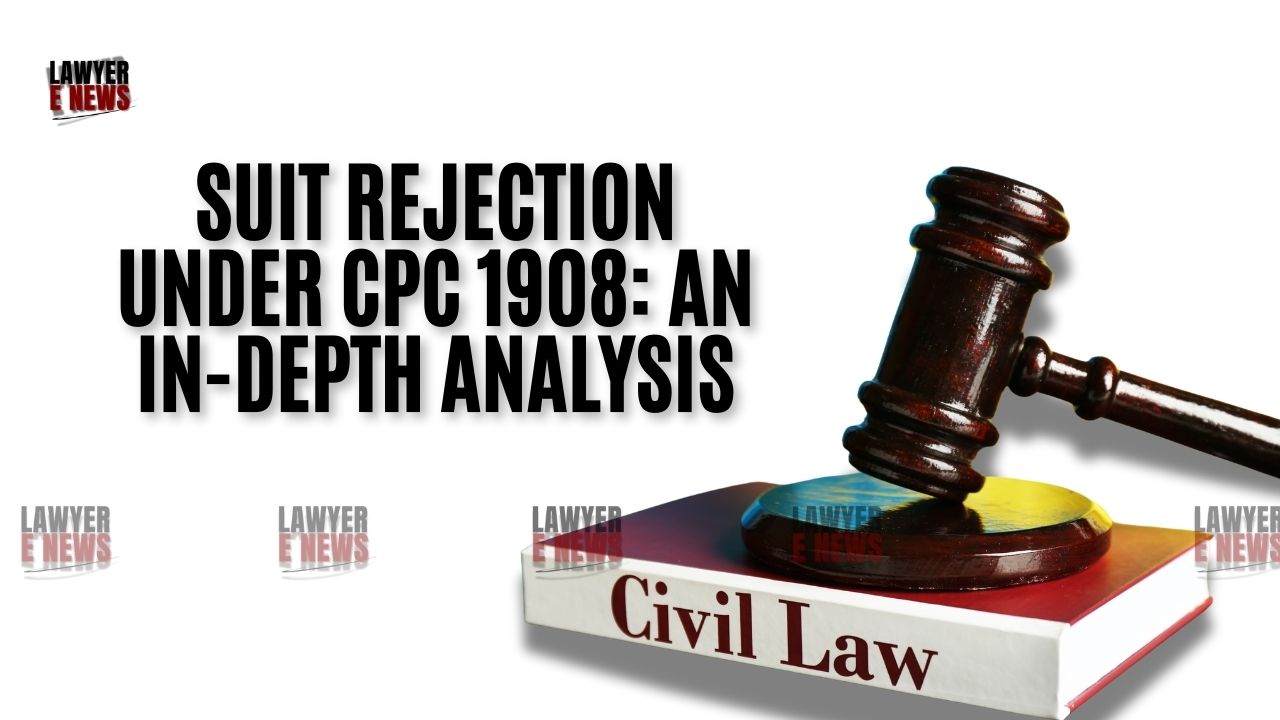


The Civil Procedure Code (CPC) of 1908 is a comprehensive statute that governs the procedure to be followed in civil courts in India. It aims to consolidate and amend the laws relating to the procedure of civil courts, ensuring a fair trial and efficient administration of justice. One of the critical provisions under the CPC is the rejection of a plaint, which is governed by Order VII Rule 11. The rejection of a plaint is a crucial procedural aspect as it determines whether a suit is maintainable before the court. This blog delves into the grounds, judicial interpretations, and implications of suit rejection under the CPC 1908.
1. Introduction to Suit Rejection under CPC
Order VII Rule 11 of the CPC 1908 empowers the court to reject a plaint at the threshold if it does not comply with certain essential requirements. The provision is designed to prevent the misuse of judicial processes by ensuring that only legitimate suits proceed to trial. The rejection of a plaint is not a decision on the merits of the case but rather a preliminary determination of whether the suit can be entertained by the court.
2. Grounds for Rejection of Plaint
Order VII Rule 11 lists specific grounds on which a plaint can be rejected:
Failure to Disclose a Cause of Action: A plaint must disclose a cause of action, i.e., the set of facts that give rise to the plaintiff's right to sue. If the plaint fails to disclose any cause of action, the court is bound to reject it.
Barred by Law: If the suit appears from the statement in the plaint to be barred by any law, the court must reject the plaint. For instance, if a suit is filed after the expiration of the limitation period prescribed by the Limitation Act, it is barred by law and liable to be rejected.
Defective Relief: When the relief claimed in the suit is undervalued and the plaintiff, despite the court's direction, fails to correct the valuation within the time fixed by the court, the plaint may be rejected.
Failure to Supply Stamp Paper: If the plaint is written on a paper insufficiently stamped and the plaintiff fails to supply the requisite stamp paper within the time allowed by the court, the plaint is subject to rejection.
Non-compliance with Rules: If the plaint does not comply with the requirements of Order VII Rule 9 of the CPC regarding the presentation and verification of the plaint, it may be rejected.
Failure to Affix the Required Court Fee: If the relief claimed by the plaintiff is properly valued but the plaint is insufficiently stamped, and the plaintiff fails to pay the requisite court fee within the time granted by the court, the plaint may be rejected.
3. Judicial Interpretation and Case Law
The judiciary has played a significant role in interpreting the provisions of Order VII Rule 11. Several landmark judgments have elucidated the scope and application of these grounds.
a. T. Arivandandam v. T.V. Satyapal & Anr. (1977) 4 SCC 467:
In this case, the Supreme Court held that if on a meaningful reading of the plaint, it is found to be vexatious and meritless in the sense of not disclosing a clear right to sue, the court should exercise its power under Order VII Rule 11 and reject the plaint. The court emphasized that the provision aims to prevent a plaintiff from dragging a defendant to court on frivolous grounds.
b. Saleem Bhai v. State of Maharashtra (2003) 1 SCC 557:
The Supreme Court in this case reiterated that the court must look at the plaint as a whole to determine whether it discloses a cause of action. The court further clarified that the power under Order VII Rule 11 can be exercised at any stage of the suit before the conclusion of the trial.
c. Popat and Kotecha Property v. State Bank of India Staff Assn. (2005) 7 SCC 510:
This case highlighted that the rejection of a plaint on the ground of being barred by law does not involve an assessment of the merits of the case but rather a consideration of whether the suit is maintainable under the law.
d. K. A. Kazi v. Muskan Bai & Anr. (2011) 3 SCC 376:
The Supreme Court in this case held that the court must not consider extraneous materials while deciding on the rejection of the plaint. The decision should be based solely on the averments made in the plaint.
4. Procedural Aspects of Suit Rejection
The rejection of a plaint under Order VII Rule 11 is a procedural aspect that requires adherence to specific norms:
Court's Duty: The court has a duty to examine the plaint meticulously to determine if it meets the criteria laid down in Order VII Rule 11. The court cannot reject a plaint without giving the plaintiff an opportunity to address the defects.
Opportunity to Amend: Before rejecting a plaint, the court may, at its discretion, allow the plaintiff an opportunity to rectify the defects, such as providing the required stamp paper or paying the court fee.
Appeal and Revision: The rejection of a plaint is a decree, and the aggrieved party has the right to appeal against it. However, if the rejection is based on technical grounds, the plaintiff may also file a revision petition under Section 115 of the CPC.
Res Judicata: A plaint rejected under Order VII Rule 11 does not bar the plaintiff from filing a fresh suit on the same cause of action if the defects leading to the rejection are rectified. However, the doctrine of res judicata may apply if the court's decision on rejection is based on substantial grounds.
5. Implications of Rejection
The rejection of a plaint has several legal implications:
Preventing Abuse of Process: The provision for rejection of plaint serves as a safeguard against the abuse of judicial processes by ensuring that only legitimate suits are entertained. It helps in reducing the burden on courts by filtering out frivolous or vexatious litigation.
Protection of Defendants: By rejecting a plaint that fails to disclose a cause of action or is barred by law, the court protects defendants from being subjected to unnecessary legal proceedings. It ensures that defendants are not dragged into baseless litigation.
Judicial Economy: The rejection of plaints at an early stage contributes to judicial economy by preventing the wastage of time and resources on suits that are not maintainable. It allows courts to focus on cases that genuinely require judicial intervention.
Access to Justice: While the provision for rejection of plaint is essential, it must be exercised with caution to ensure that genuine claims are not dismissed without a fair hearing. The balance between preventing misuse of the legal process and ensuring access to justice is crucial.
6. Distinction between Rejection of Plaint and Dismissal of Suit
It is essential to distinguish between the rejection of a plaint and the dismissal of a suit. The rejection of a plaint under Order VII Rule 11 is based on procedural grounds, such as non-disclosure of a cause of action or non-payment of court fees. It does not involve an examination of the merits of the case.
On the other hand, the dismissal of a suit occurs after a trial on merits, where the court finds that the plaintiff has failed to prove his case. The dismissal of a suit has a more profound impact, as it generally bars the plaintiff from re-litigating the same issue.
7. Challenges and Criticisms
The provision for rejection of a plaint, while necessary, has faced some criticisms:
Strict Interpretation: Some argue that courts sometimes adopt a too-strict interpretation of Order VII Rule 11, leading to the rejection of genuine claims. This strict approach can potentially deny plaintiffs the opportunity to have their day in court.
Delay in Proceedings: While the intention behind the provision is to expedite proceedings, in practice, applications for rejection of plaint can sometimes lead to delays. Defendants may use this provision to stall proceedings, leading to protracted litigation.
Judicial Discretion: The application of Order VII Rule 11 involves a significant degree of judicial discretion. This discretion must be exercised judiciously to avoid arbitrary or unjust decisions. Inconsistent application of this discretion can lead to uncertainty and unpredictability in the legal process.
Impact on Access to Justice: Overemphasis on procedural compliance at the cost of substantive justice can undermine the principle of access to justice. Courts must strike a balance between ensuring procedural rigor and providing fair opportunities to litigants to present their cases.
Order VII Rule 11 of the CPC 1908 is a vital provision that serves as a gatekeeper in civil litigation. It ensures that only suits with legitimate grounds proceed to trial, thereby preventing the misuse of judicial processes. The rejection of a plaint under this provision is a powerful tool in the hands of the judiciary to maintain the sanctity of the legal process.
However, the exercise of this power must be balanced with the need to provide access to justice. Courts must ensure that genuine claims are not dismissed on technical grounds, and litigants are given a fair opportunity to rectify defects in their plaints.
The evolving judicial interpretations of Order VII Rule 11 continue to shape its application in contemporary legal practice. As courts navigate the complexities of this provision, they must remain mindful of the broader objectives of the CPC—to facilitate the just, expeditious, and economical resolution of civil disputes.